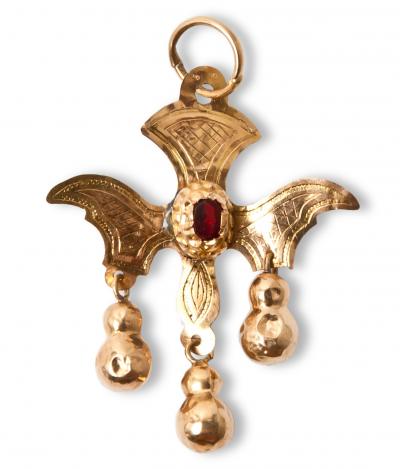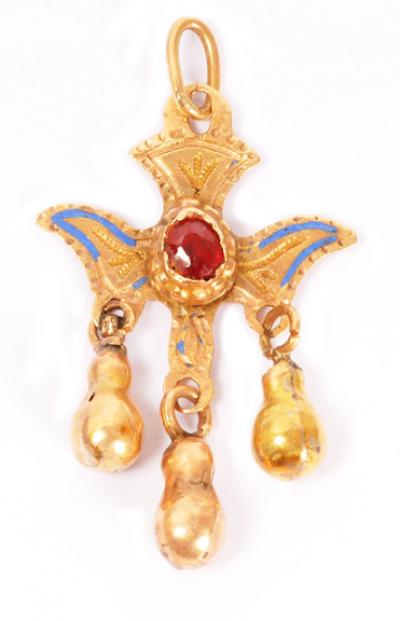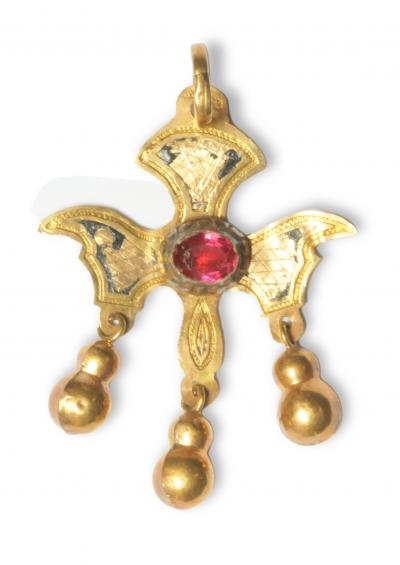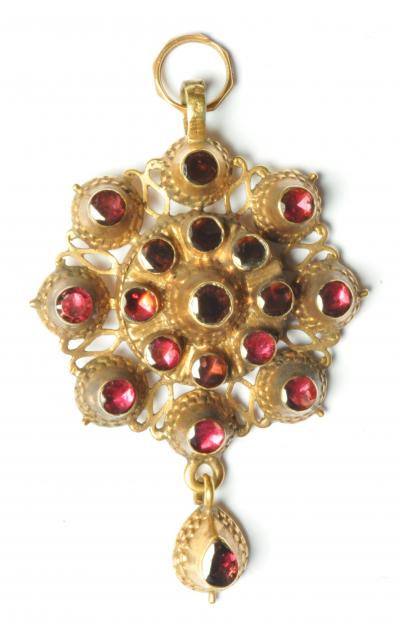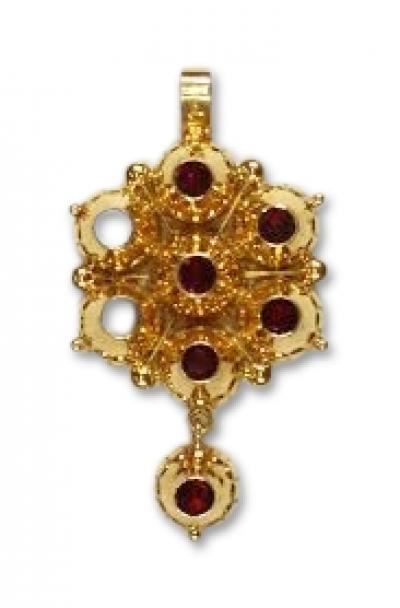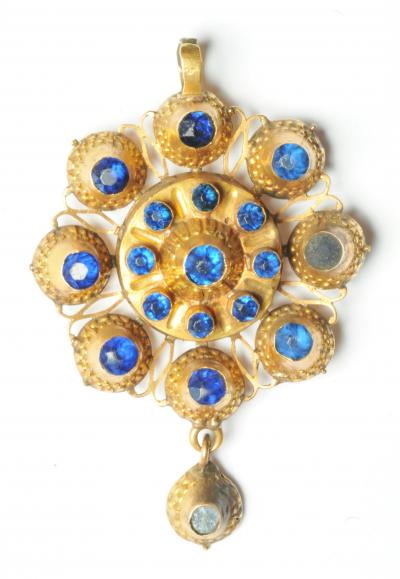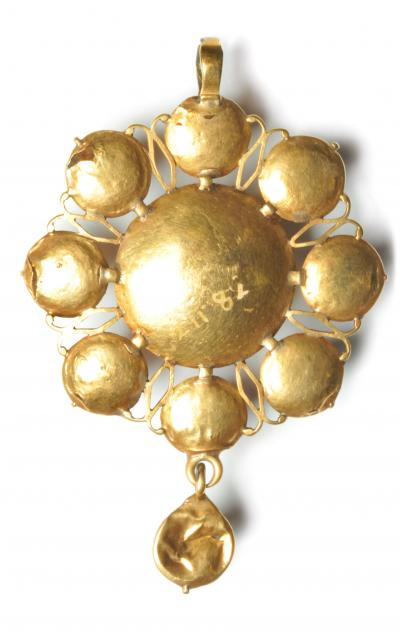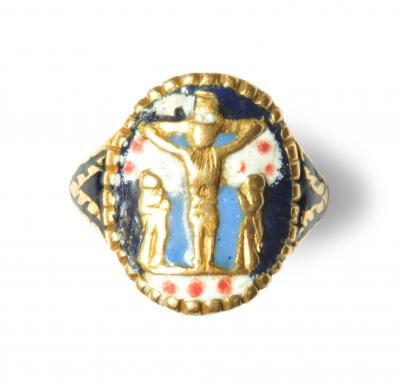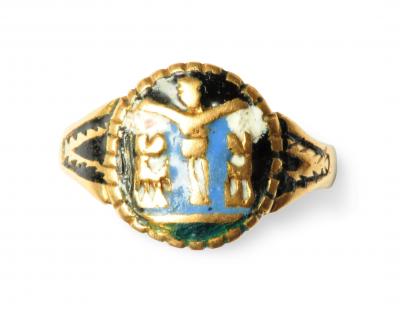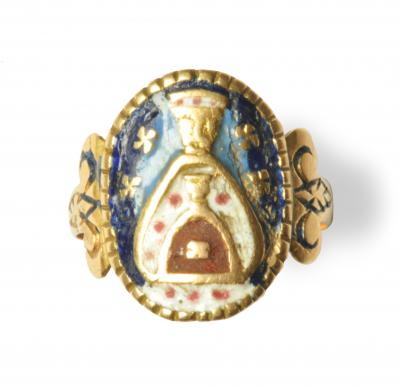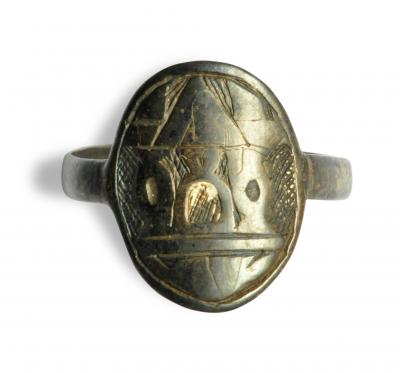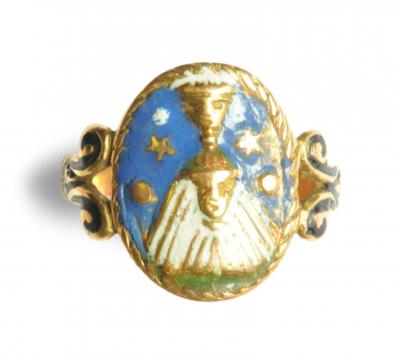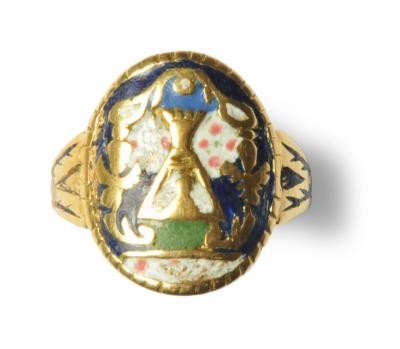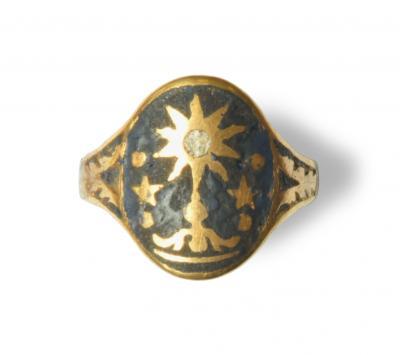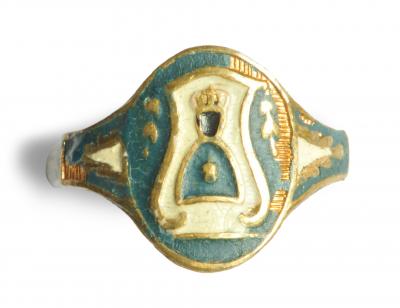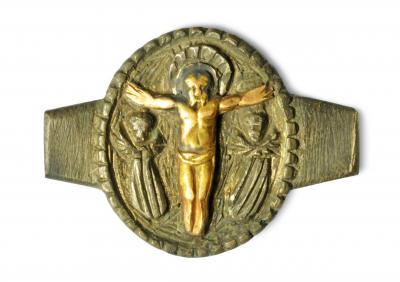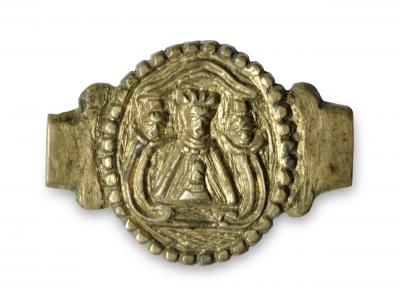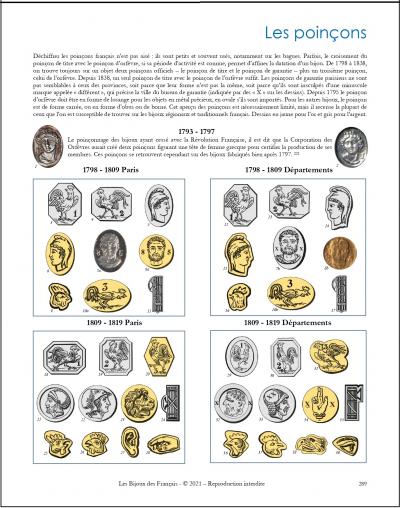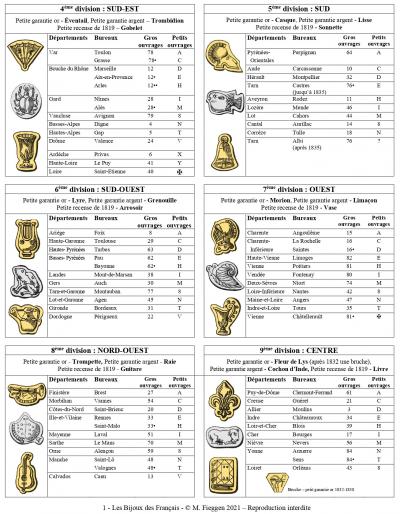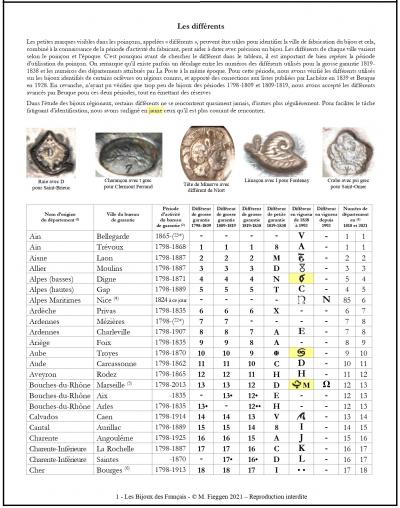Auvergne

French regional jewellery - Auvergne
BIJOUX REGIONAUX AN
CIENS - BIJOU REGIONAL
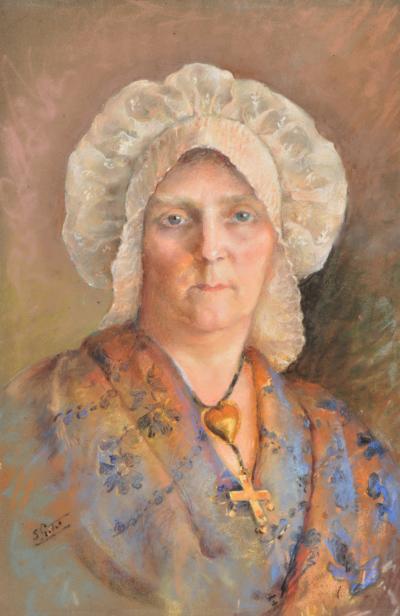
folk costume and cross from Auvergne
The regional jewellery from Auvergne is characterised by enamelled crosses and Holy Spirit pendants of varying shapes, depending on the exact area of production and use. The crosses always had three drop-shaped pendants hanging from the arms and the base which most likely represented the tears of Christ who was said to have wept three times (though some say they represent the lead tips on the whips used by the Romans to flagellate Christ.) These tears are sometimes missing from the crosses and it is likely that they were removed by their owners either to keep up with fashion or to balance out the design when one of them was lost.
The Holy Spirit pendants are very stylised and in some cases, such as those from Brioude or Clermont Ferrand, they look more like crosses and it is possible that they indeed evolved from crosses. These pendants are set with garnets and sometimes with citrines which are backed with foil. The foil is generally embellished with a red spot in the centre, and this gives the citrine a colour which changes according to the angle from which it is viewed.
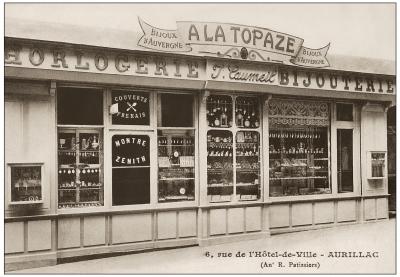
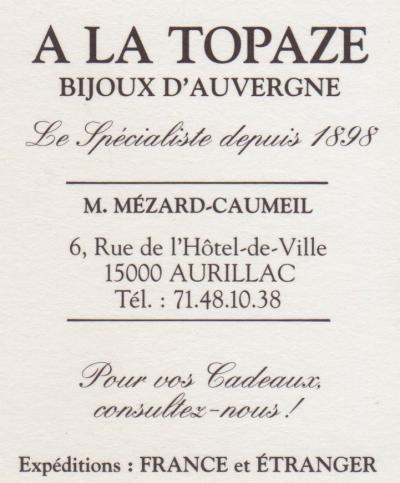
Jeweller "A la Topaze" d'Aurillac, specialising in reginal jewellery from Auvergne
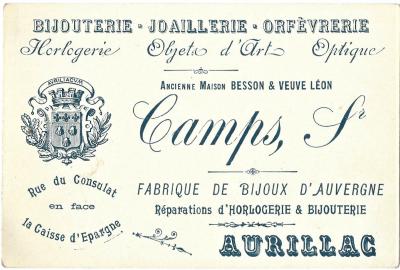
Jewllery shop of Mr. Camps fromAurillac, specialising in reginal jewellery from Auvergne
In the section of this site devoted to Savoy, you can see an invoice made out to him showing that he
bought antique and modern regional jewels from Mr. Bonsaquet from Chambéry
Holy Spirit cross from Clermont-Ferrand
The Holy Spirit cross of Clermont-Ferrand is set with five pear-cut garnets and garnished with three drop-shaped pendants. The pendants are sometimes smooth, sometimes striated. The Holy Spirit is sometimes suspended from an additional pear-shaped element with small garnets.
Holy Spirit cross from Brioude

Holy Spririt from Brioude,
gold and garnets, front |
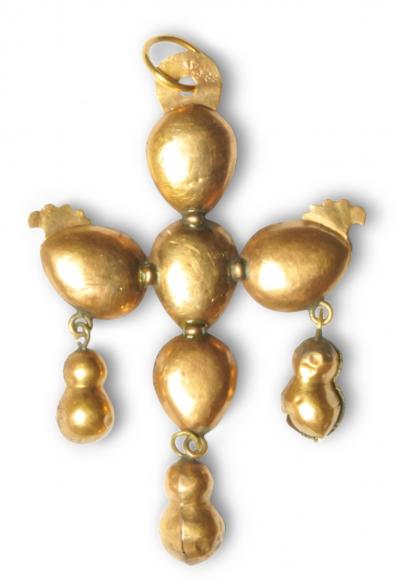
Holy Spririt from Brioude,
gold and garnets, back view |
|
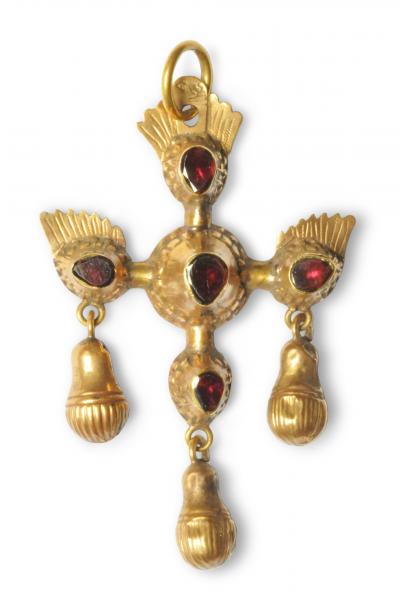
Holy Spririt from Brioude,
gold and garnets, front |
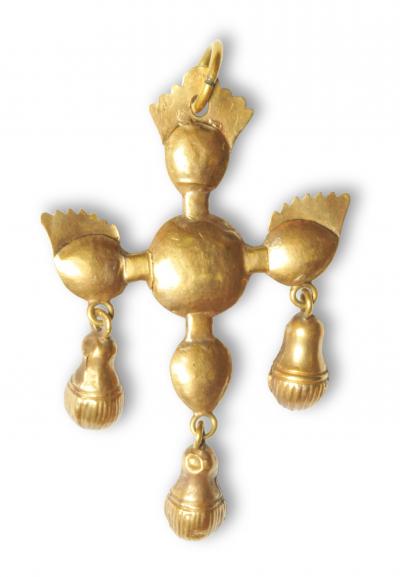
Holy Spririt from Brioude,
gold and garnets, back view |
The Holy Spirit of Brioude, also known as the Brioude cross, is similar to the Holy Spirit of Clermont Ferrand but is distinguished by its rudiments of wings and its tail, underlined by engravings. Five garnets, round or pear-shaped, are set in the body and three drop-shaped pendants are suspended. The pendants are sometimes smooth, sometimes striated.
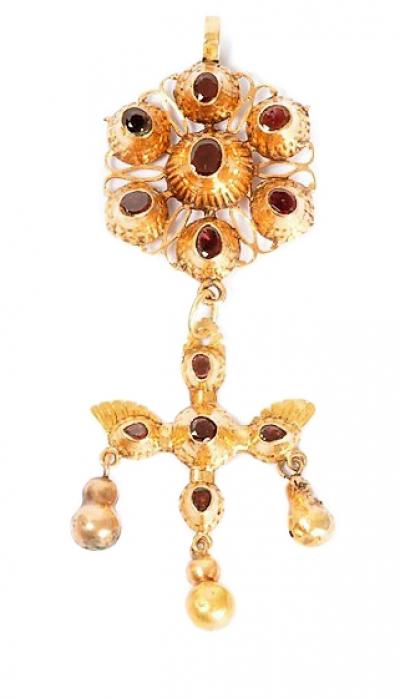
Holy Spirit pendant from Brioude, with its rose of Velay suspension, both in gold set with garnets
also called "croix de Brioude"

Holy Spirit pendant from Brioude in gold set with garnets
also called "croix de Brioude"
Léon Giron (1839-1914), "La dentellière d'Espaly", Musée Crozatier, Le Puy en Velay
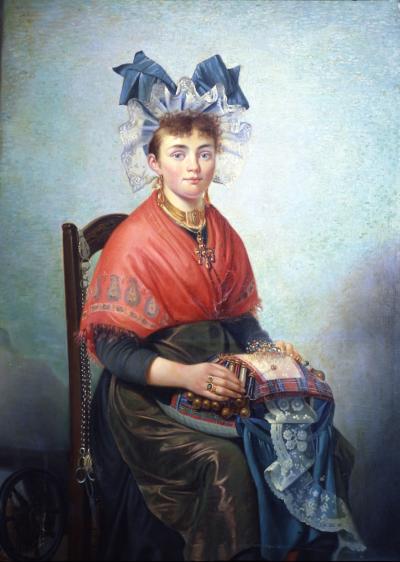
Léon Giron (1839-1914), "La dentellière d'Espaly", Musée Crozatier, Le Puy en Velay
necklace with Holy Spirit pendant, earrings, rings and a chatelaine on the chair
Flat cross from Le-Puy-en-Velay
|
|
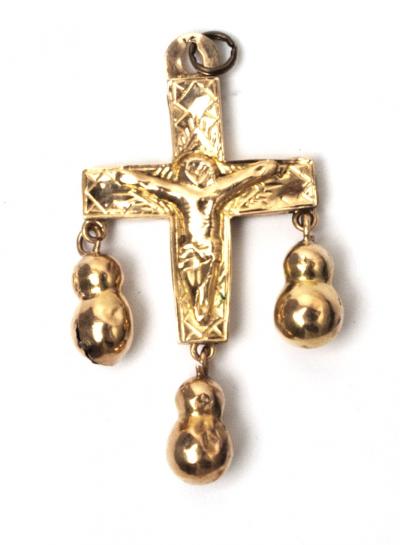
Flat cross, gold |
|
There is a multitude of crosses known from Le Puy-en-Velay. Most were not intended to be worn by the locals but were made to sell to the many pilgrims attracted by Notre Dame du Puy. Since the end of the nineteenth century jewelers have made re-editions of old Auvergnat jewelry, often using the old dies and with more or less skill. The flat cross is a simple, hollow flat cross with a crucifixion on one side and from which three drop-shaped pendants are suspended. The pendants are generally smooth, sometimes striated.
Flat cross from Le Puy en Velay, gold
The embellished cross from Le Puy-en-Velay
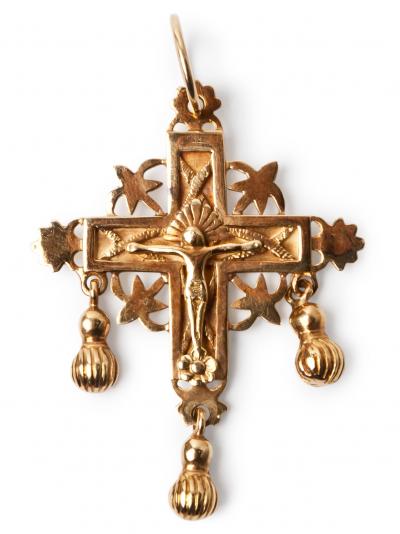
embellished Velay cross, gold
The embellished cross from Le Puy-en-Velay is similar to the flat cross except that the intersections of the arms are embellished with cut-out designss and the ends of the arms by stars. Three striated or smooth teardrop pendants hang from the arms.
The menette cross
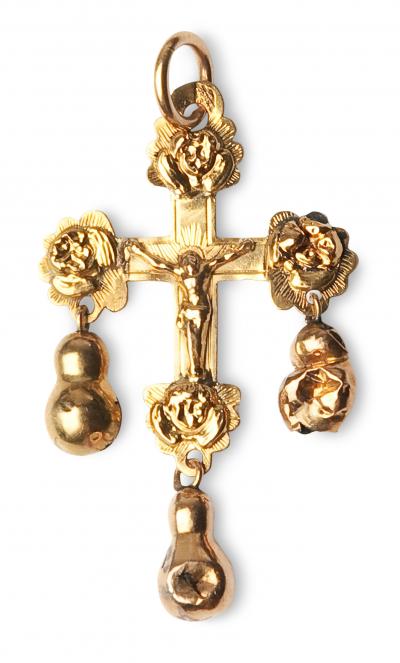
Menette cross, gold
The hollow menette cross incorporates a raised Christ surrounded by four winged angel heads, each placed on the ends of the cross in the shape of palmettes. Three tear-drop shaped pendants with or without striations are suspended from the arms. The menettes were religious women who had taken a vow of chastity, but did not live at the convent. The four cherubs represent Matthew, Mark, Luke and John (1)
The enamelled cross from Le Puy-en-Velay
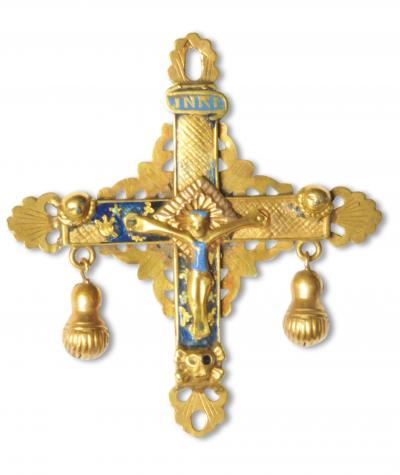
Enamelled gold cross from Le Puy-en-Velay, front |
|
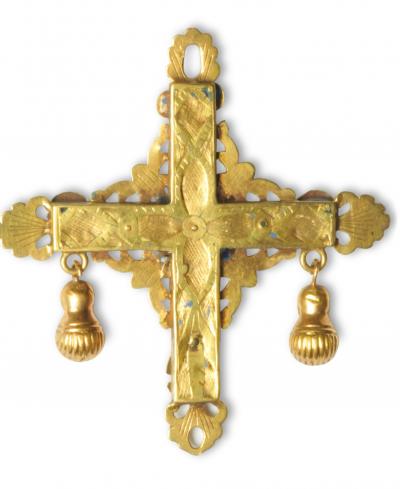
Enamelled gold cross from Le Puy-en-Velay, back |
The enamelled cross of Puy-en-Velay features, on one side, Christ embossed on a blue email background dotted with stars, on the other Mary on a starry blue background. The ends of the arms are shaped like palmettes. The sides of the arms and their intersections are sometimes embellished with cut-out decorations. Three tear-drop shaped or spherical pendants with or without striations are suspended from the arms.
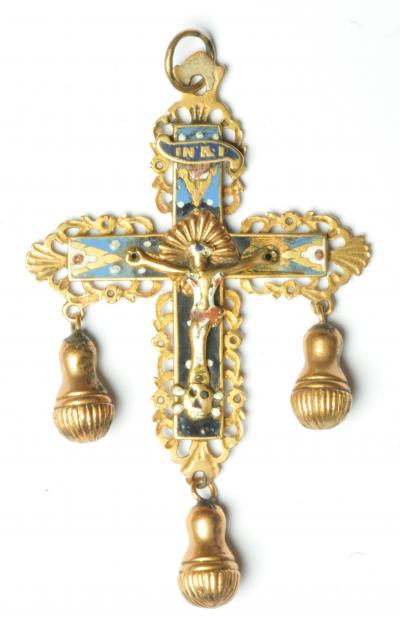
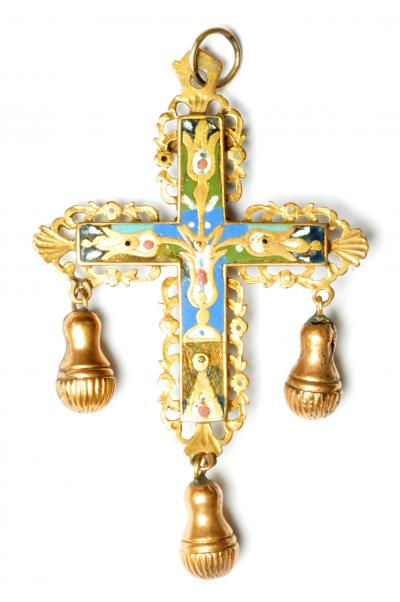
enamelled cross from Le Puy-en-Velay in gold and enamel
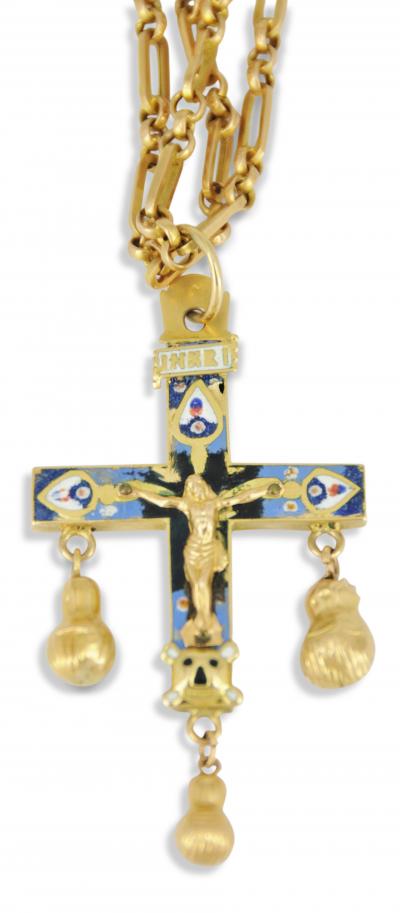
enamelled cross from Le Puy-en-Velay with it's chain
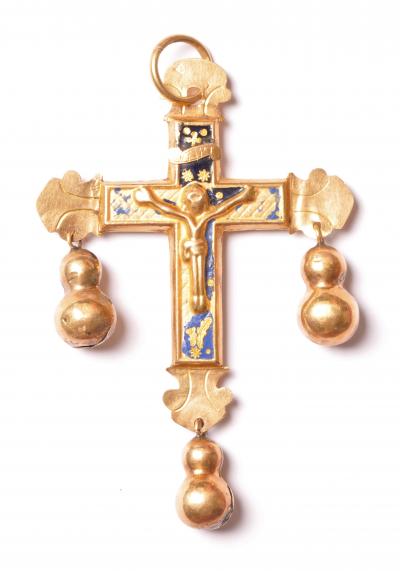
enamelled cross from Le Puy-en-Velay, front |
|
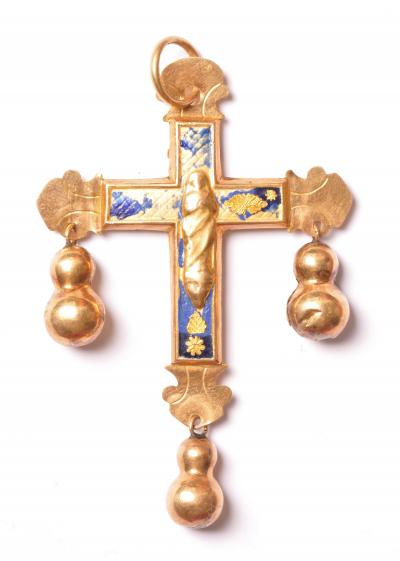
enamelled cross from Le Puy-en-Velay, back |

enamelled cross from Le Puy-en-Velay with four enamelled plates, probably offered to mark the birth of each child
(the tear-drop pendants on the cross are missing and were perhaps removed when they became old fashioned or to balance out the design when one was lost)
|

Croix du Puy en Velay en or et email, recto
|
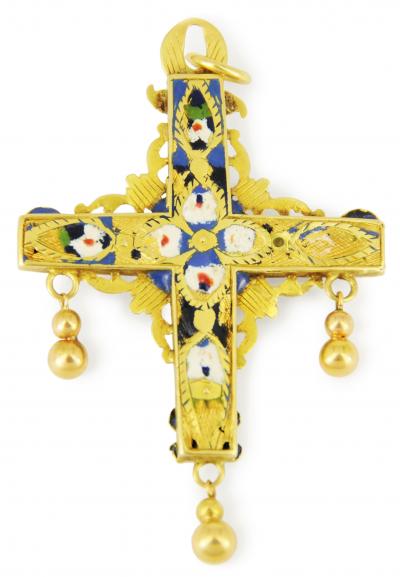
Croix du Puy en Velay en or et email, verso |
enamelled cross from Le Puy-en-Velay, front and back views
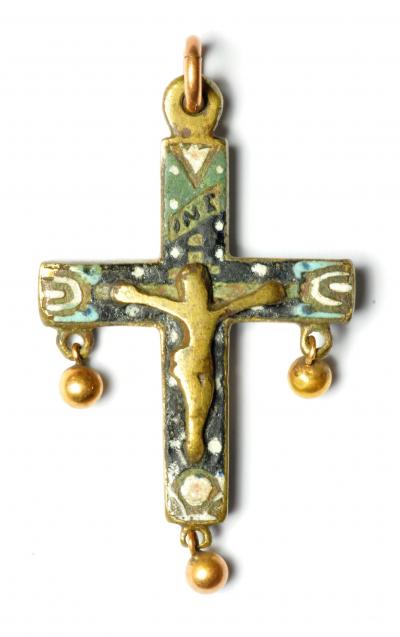
Croix du Puy en Velay bronze et email (recto) |
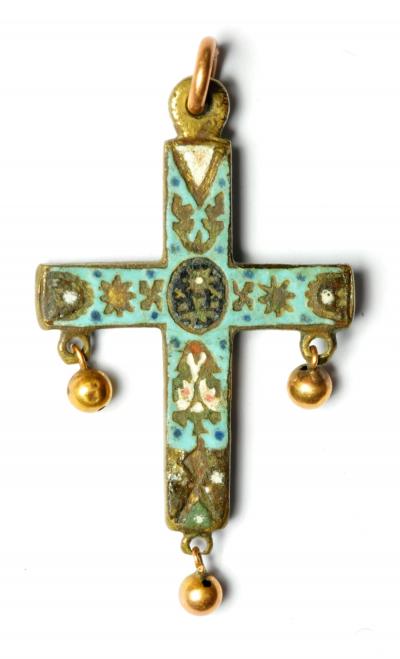
Croix du Puy en Velay bronze et email (verso) |
|
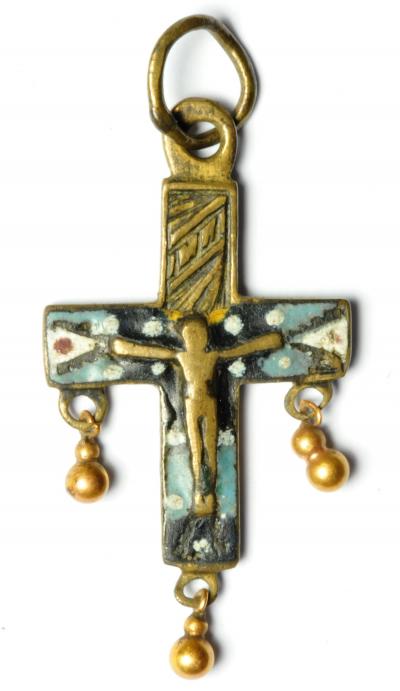
Croix du Puy en Velay bronze et email (recto) |
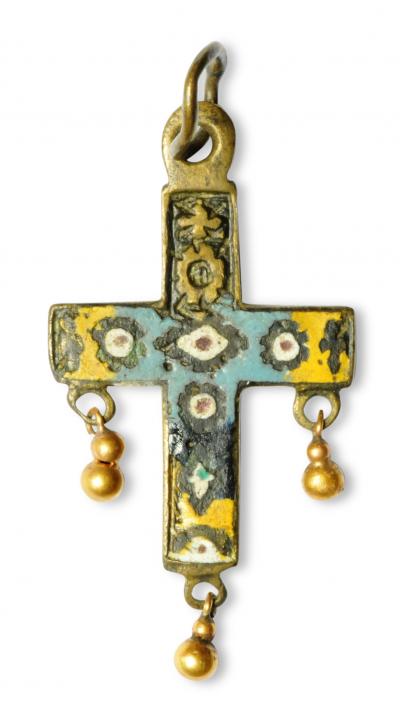
Croix du Puy en Velay bronze et email (verso) |
two enamelled crosses from Le Puy-en-Velay, front and back views
The Puy gemstone cross
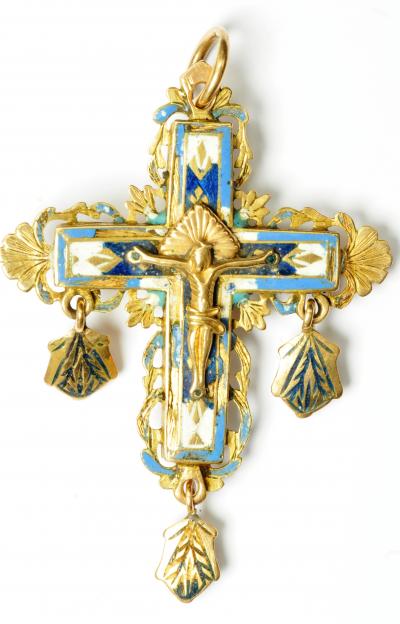
cross from Le Puy-en-Velay
gold, enamel and glass (front) |
|
|
|
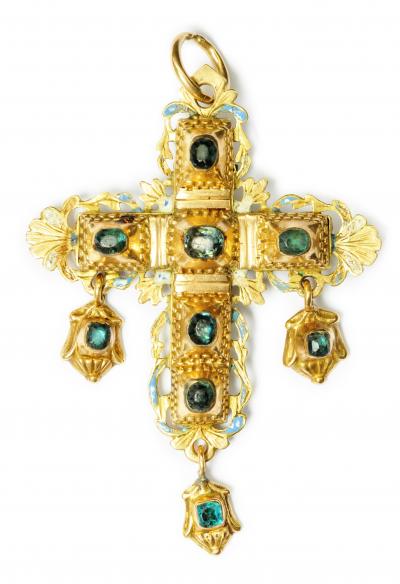
cross from Le Puy-en-Velay
gold, enamel and glass (back) |
The Le Puy-en-Velay gemstone cross is decorated on one side with sapphires from Le Puy or rhinestones. The structure of the cross is bordered by openwork scrolls and palmettes and garnished with blue enameled spots. The three pendants are flat, hexagonal and indented and are set on one side with stones and decorated on the other side by engraved and enameled designs. The other side of the cross often but not always features the Christ and is always decorated with enamel.
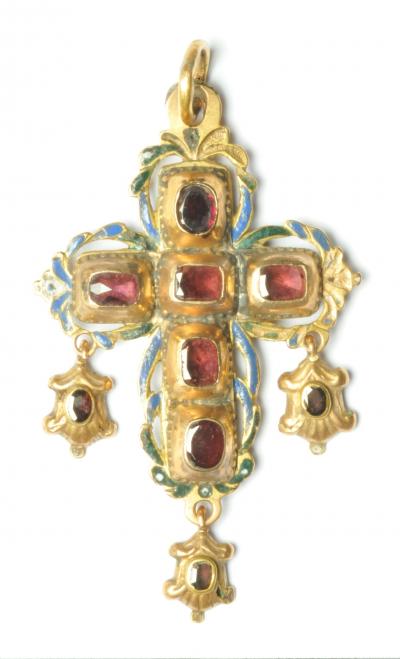
cross from Le Puy en Velay gold, enamel and glass (front) |
|
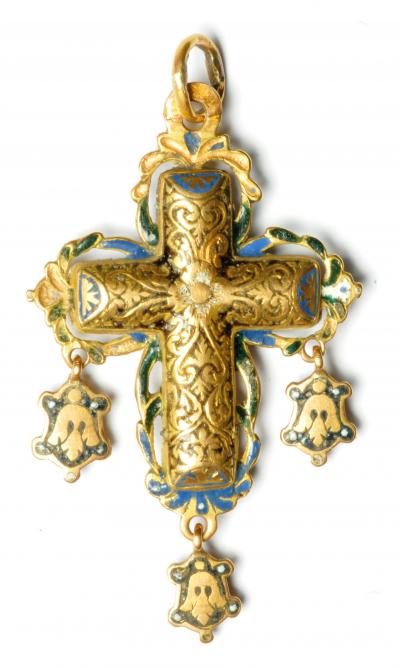
cross from Le Puy en Velay gold, enamel and glass (back) |
cross from Le Puy-en-Velay gold, enamel and glass
![Thomas Degeorge - Paysanne assise, 1852 - Musee d'Art Roger-Quilliot [MARQ], Ville de Clermont-Ferrand](/ckfinder/userfiles/images/petits/thomas-degeorge-paysanne-assise.jpg)
Thomas Degeorge 1786 - 1854 - Paysanne assise, 1852
with the kind permission of the museum of art Roger-Quilliot [MARQ], town of Clermont-Ferrand
Holy Spirit pendant from Le-Puy-en-Velay
The Holy Spirit pendant from Le Puy-en-Velay is cut out of a sheet of very thin gold, which is then engraved and enamelled. A citrine or garnet is set in a rather high mounting at the centre. Three tear-shaped drops are suspended from the pendant. The thin gold is very susceptible to deformation and this leads to the pendants losing their enamel ; the enamel is virtually never found intact.
|
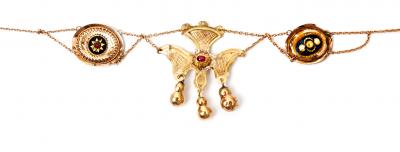
Holy Spirit necklace from Le Puy en Velay, gold, enamel and garnet
note the two different plaques - quite possibly purchased separately after the births of children
|
Rose pendant from Le Puy-en-Velay
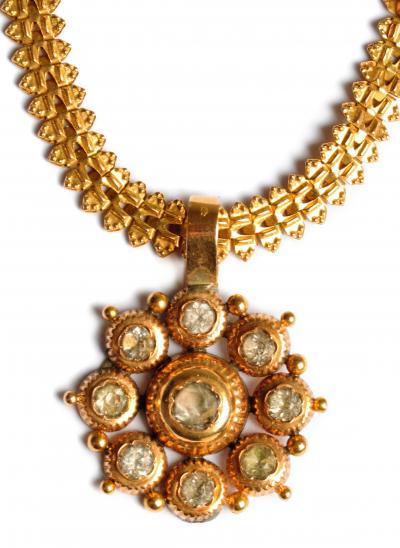
rose of Velay pendant with its chain, gold and glass
The Rose of Velay pendant is a traditionnal jewel from Le Puy-en-Velay, where it is still worn today. It is set with one or two circles of stones, which are either in glass or garnets, the design of the goldwork between the stones varies between jewels but the basic design is characteristic.
Holy Spirit pendant from Aurillac
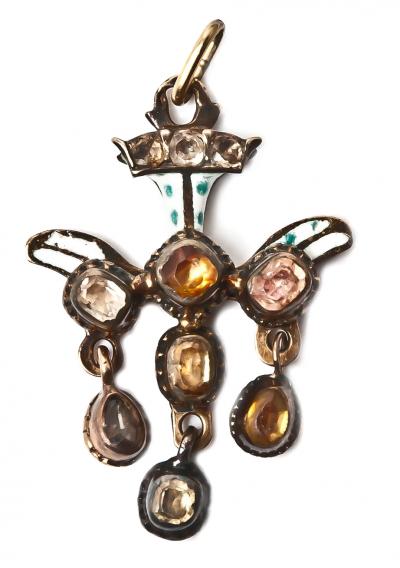
Holy Spirit of Aurillac pendant, silver, citrines and enamel
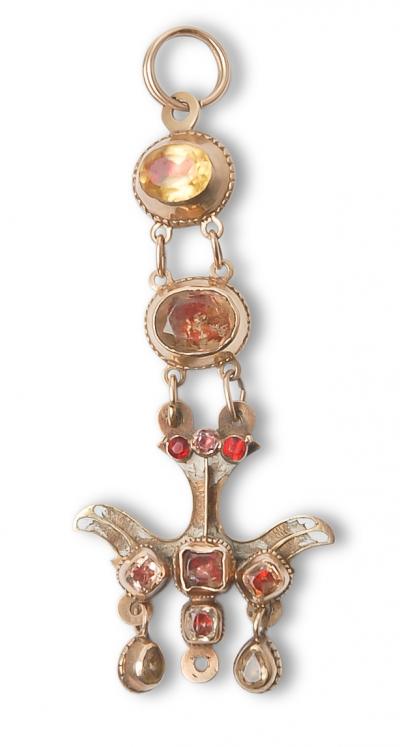
Aurillac Holy Spirit pendant,
gold, enamel and citrine or topaz |
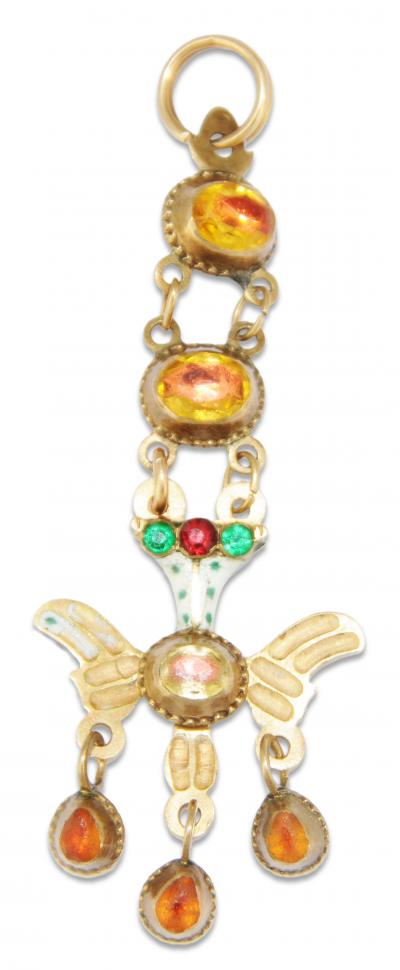
Holy Spirit from Aurillac,
gold, enamel and citrines or topaz |
zz |
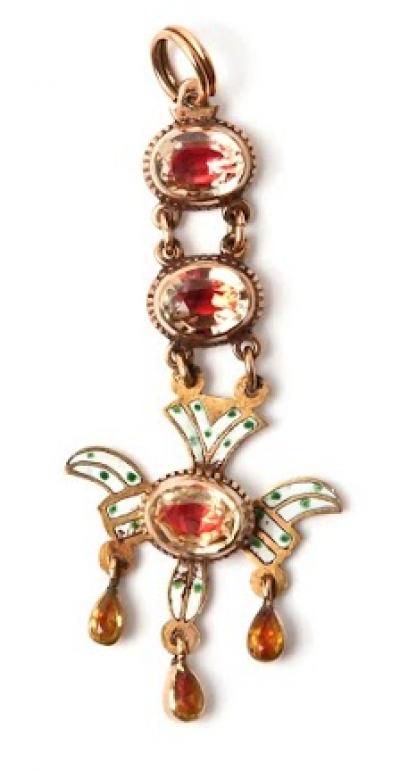
Aurillac Holy Spirit pendant,
gold, enamel and citrine or topaz |
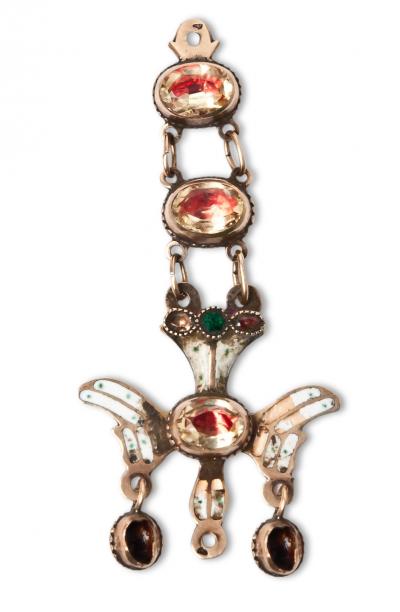
Aurillac Holy Spirit pendant,
gold, enamel and citrine or topaz |
In and around the town of Aurillac, the Holy Spirit pendants are still worn by many women and they are sold in most jewellery shops. They are usually set with citrines or topazs on a coloured foil base which changes the colour of the stones depending on the angle at which it is viewed. The gold is very thin on the old Holy Spirit pendants and the enamel is thus generally found to be damaged. It is said that extra sliders or plaques for the crosses and pendants were offered to women to mark the birth of each child.
Donades cross from Le-Puy-en-Velay
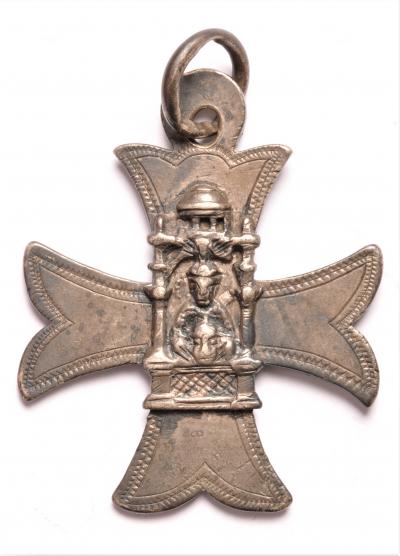
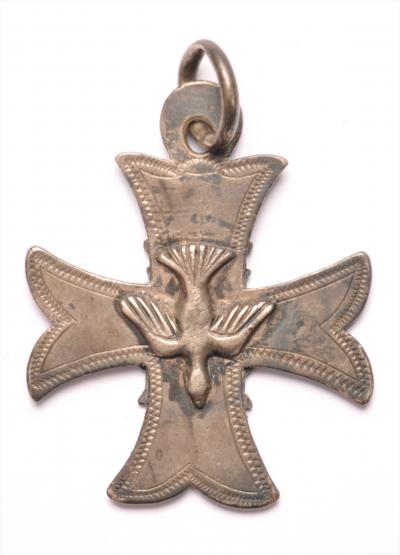
Donades cross from Le-Puy-en-Velay in silver, worn by the religious helpers at the Hôtel Dieu hospital in the 19th century
The simple gemstone cross from Auvergne
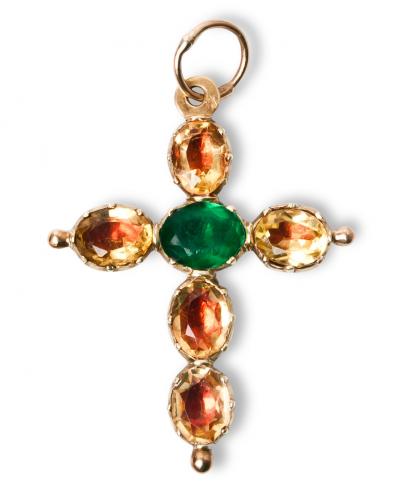
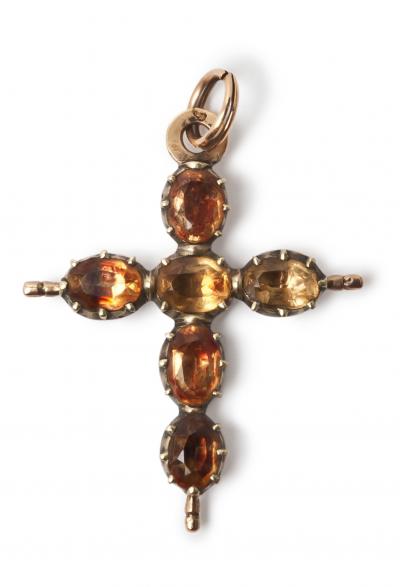
Auvergne cross, gold and citrines
Other crosses and jewels from Auvergne
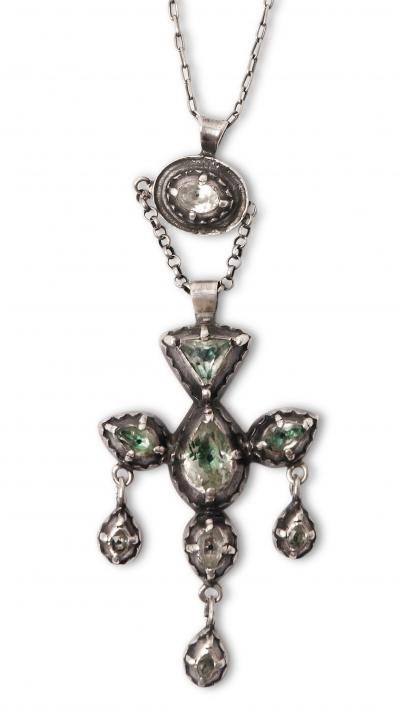
Cross from Auvergne, silver and glass
This cross, while seemingly Auvergnat in appearance, tends to be encountered throughout France and is always found with Parisian hallmarks. I suspect it is a Parisian invention, made and sold between 1870 and 1920 when regional jewellery became extremely fashionable to wear in the cities. It is of no interest to collectors.
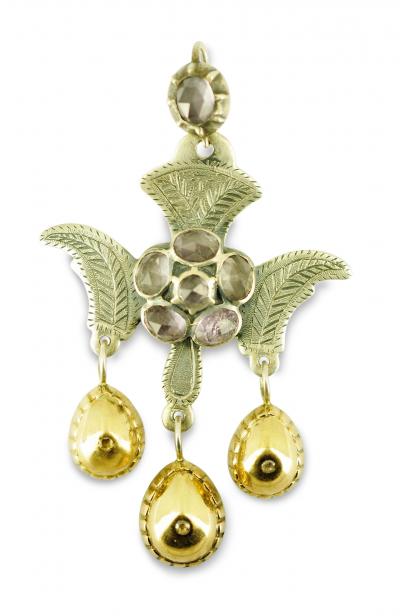
Holy Spirit pendant, gold, silver and glass
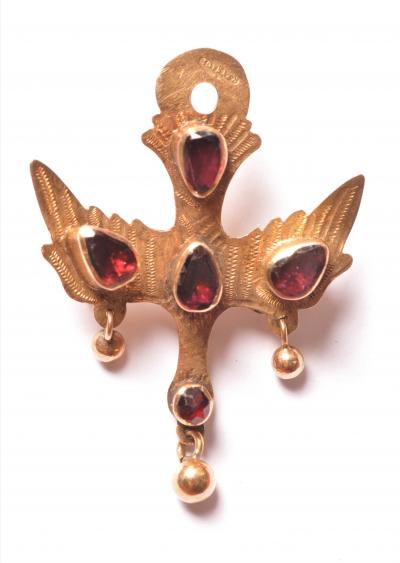
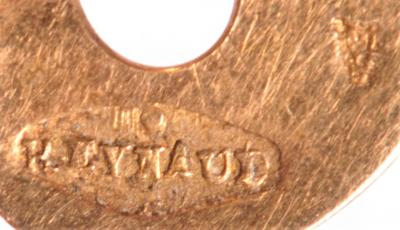
Holy Spirit pendant from Auvergne (?) in gold and garnets
|
|
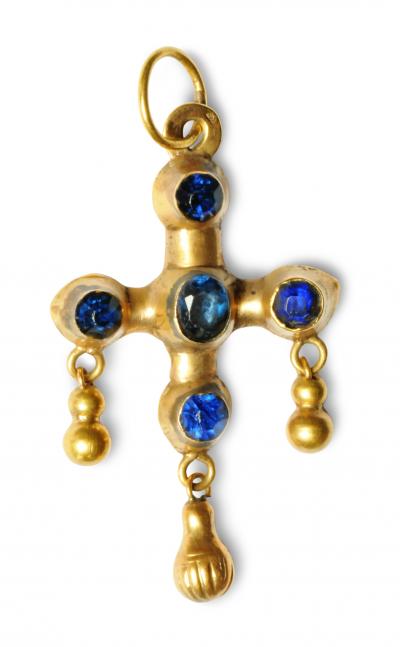
Auvergne cross in gold and glass, front view |
|
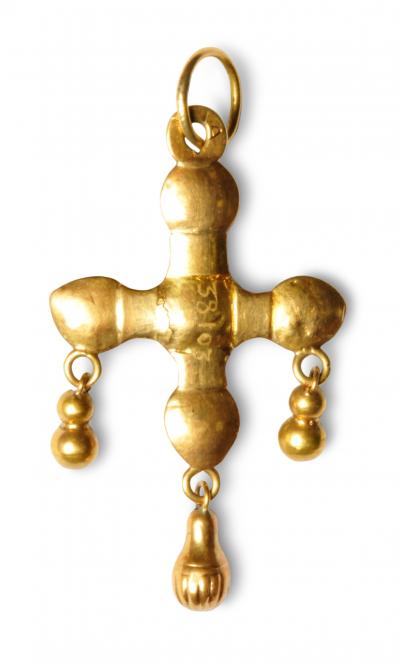
Auvergne cross in gold and glass, back view |
|
|
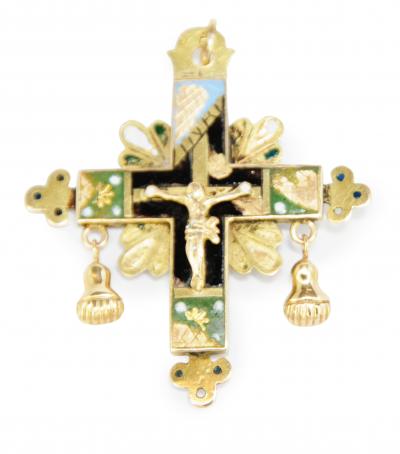
Auvergne cross, gold and enamel
|
|
|
|
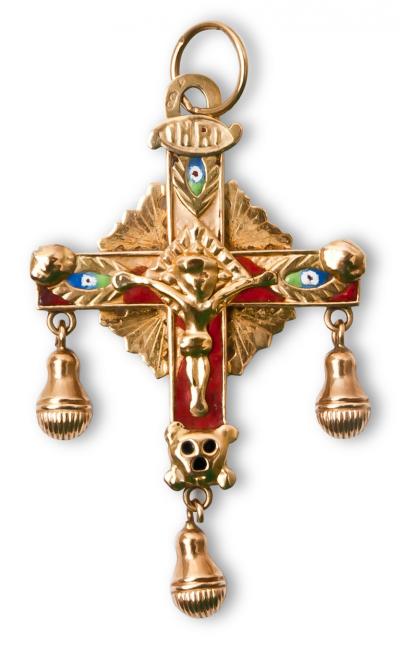
Auvergne cross, gold and enamel
|
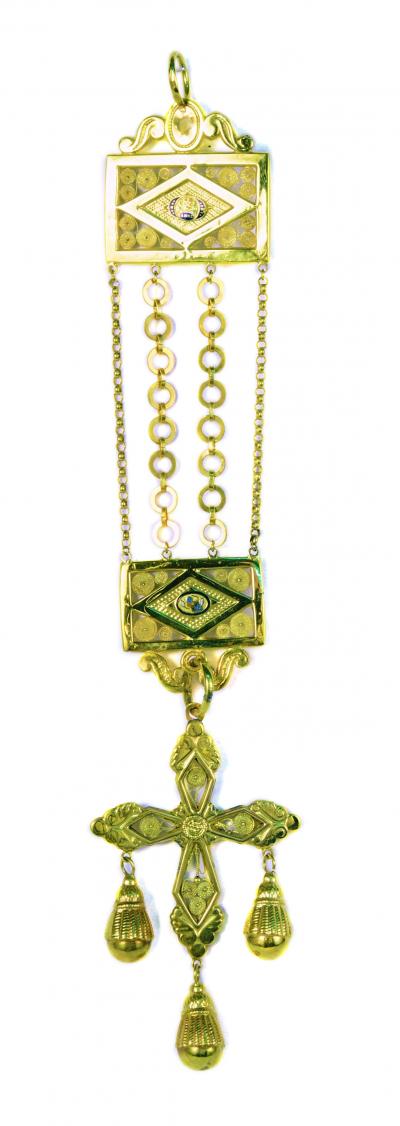
Auvergne cross on chains in gold with enamel
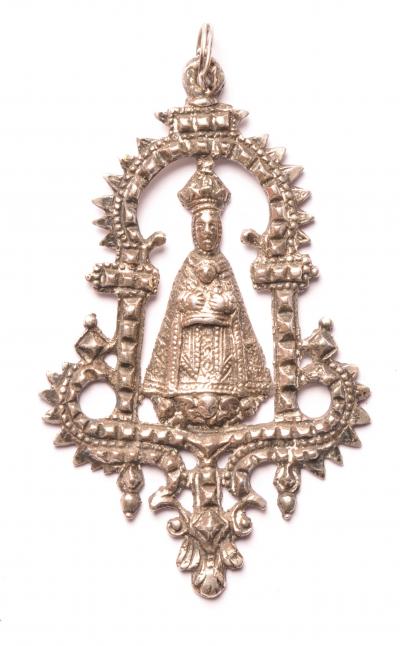
silver pendant from Notre Dame du Puy en Velay
Coiffe pins from Auvergne
|
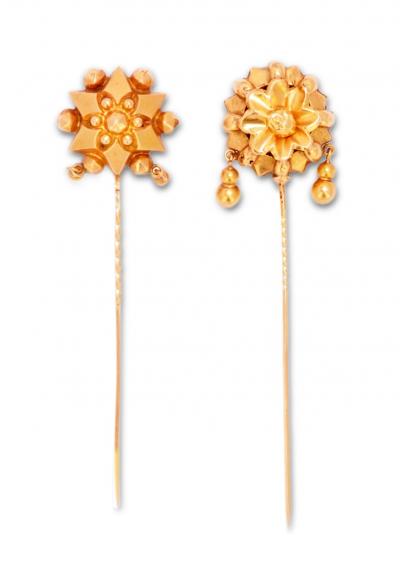
a pair of Auvergnat coiffe pins in gold
|
|
|
|
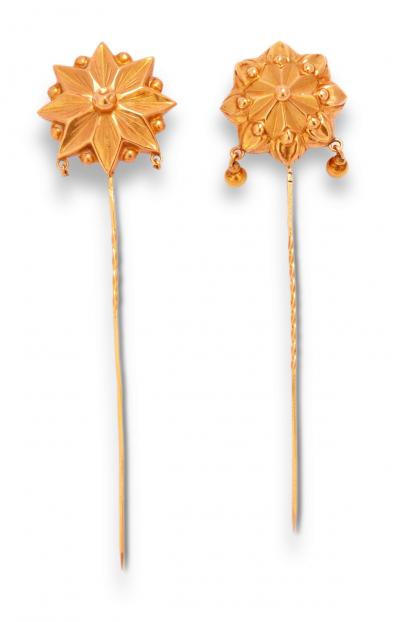
a pair of Auvergnat coiffe pins in gold
|
The Auvergnat coiffe pins, with their flattened shape and their pendants, are unique to this region. The two coiffe pins in a pair are only rarely identical.
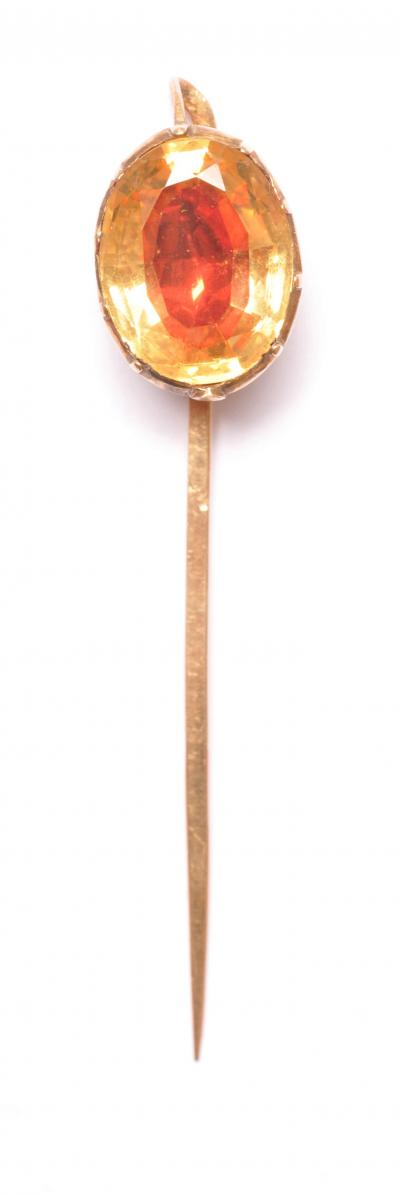
coiffe pin from Auvergne in gold set with a citrine
Earrings
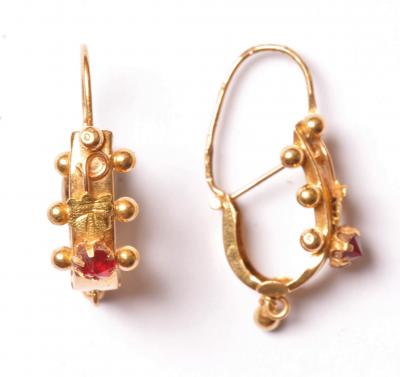
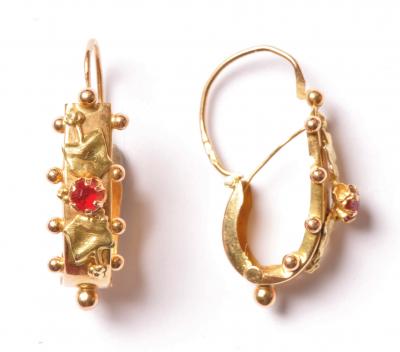
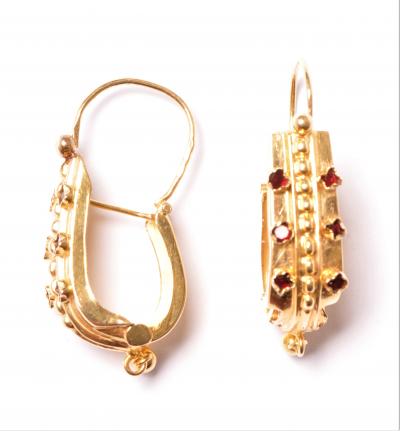
Three pairs of "briquet' ear pendants, popular from Auvergne to the Dauphiné region
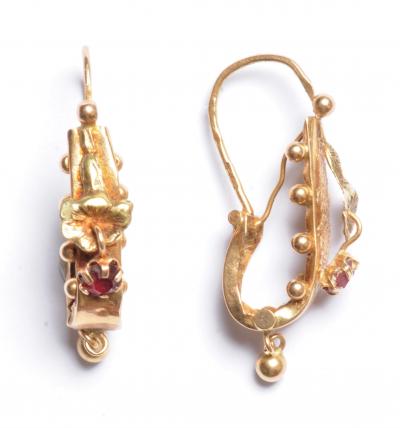
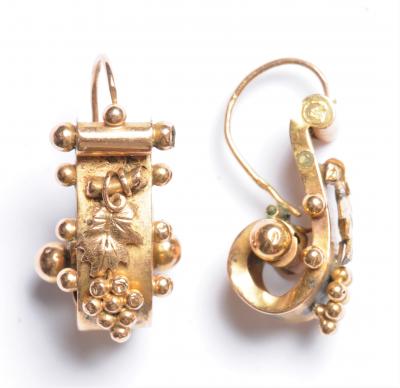
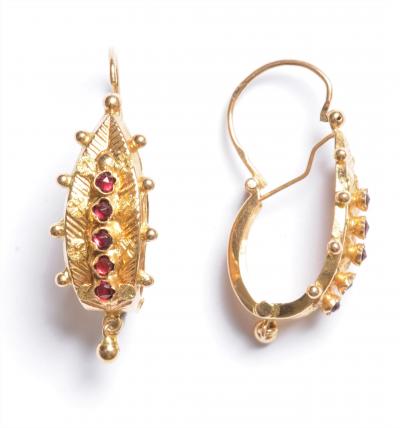
Three pairs of "briquet' ear pendants, popular from Auvergne to the Dauphiné region
Jubilee rings
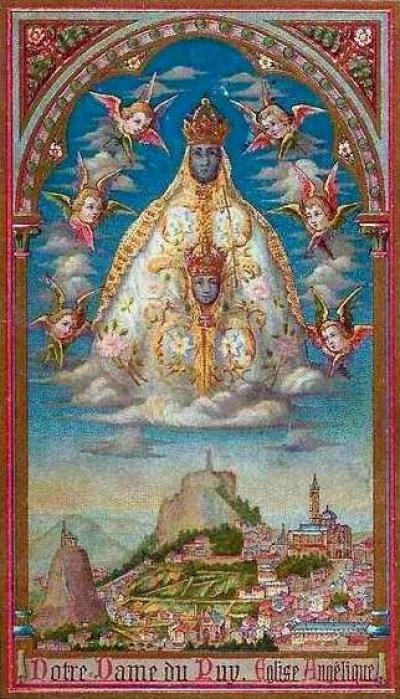
Our Lady of Le-Puy-en-Velay
Le Puy en Velay has been an important pilgrimage site for over a thousand years, to worship Mary. A jubilee year is proclaimed when Good Friday falls on the same day as Ascension, which happens roughly every eleven years however there can be a gap of over a hundred years. A jubilee was held in 2005, the last one was celebrated in April 2016 and the next one will occur in 2157! The jubilee, also known as a Grand Pardon, offers the opportunity for the absolution of sins too serious to be absolved in a normal confession. There is consequently a large influx of pilgrims (sinners?) during the jubilee and in the past many of them bought a jubilee ring as a souvenir of their visit.
The history of rings from Le Puy en Velay is certainly very old: in the last will and testament of Count Eude of Nevers dated 1266, one finds mention of "XI petiz eniaus dou Pui" (eleven small rings from Puy). (3)
"Rings are one of the most curious parts of the peasant jewels of the Velay, because they have kept their age-old character. Today, as in the past, they are the symbol of the attachment to the worship of the Black Madonna of Puy. Generally in gold, very rarely in silver, they are characterised by a very narrow ring connecting to an enameled oval on which is represented the Madonna with or without a niche in a rather crude schematisation.
The silversmith also represented other religious symbols that could satisfy all the fancies of the buyer: crucifix, monstrance, chalice, chapel, pascal lamb, etc. The dimensions, the shapes, the ornamentation, the thickness vary as well as the colour of the enamel; we have blue, red, green and white." (1)
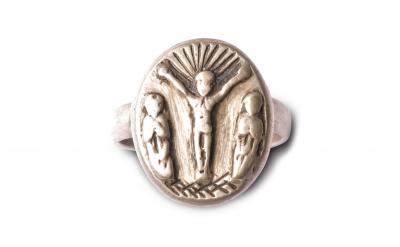
jubilee ring in silver
|
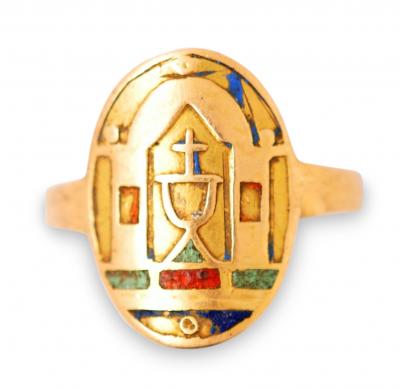
chalice ring in enamelled gold
|
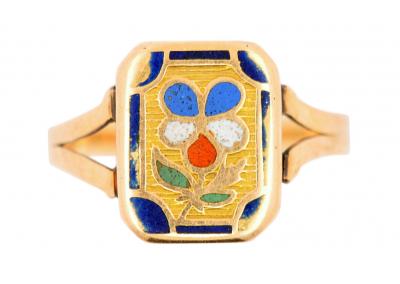
enamelled Pansy ring |
|
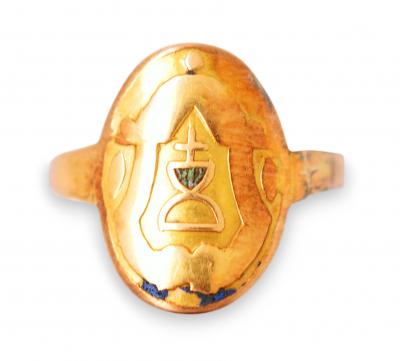
chalice ring in enamelled gold
|
|
'Slave' necklaces
The "esclavage" or slave necklaces from Auvergne tend to have rectangular plates, often with openwork and decorated with filigree, quite different from those of Normandy or Burgundy where oval plates tend to predominate. The slave necklaces from Auvergne can also be distinguished by the two rigide swags that are generally suspended from the central plate.
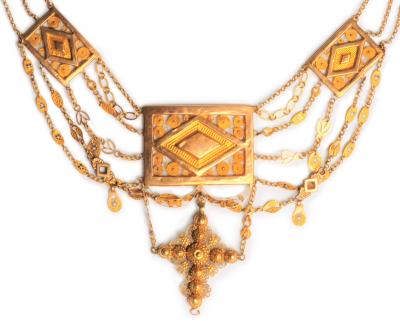
esclavage (slave) necklace from Auvergne region, gold
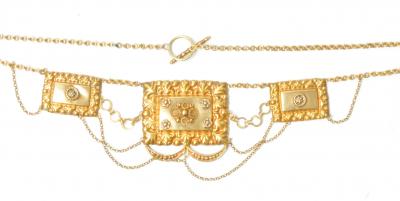
esclavage (slave) necklace from Auvergne region, gold
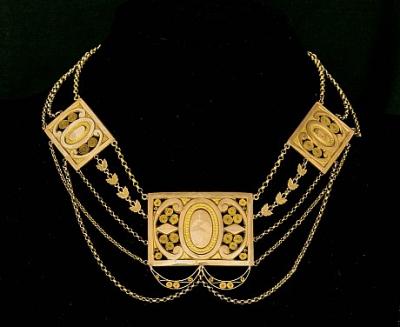
esclavage (slave) necklace, gold
The 'rangs d'or' necklace

The "lacemaker of Espaly" painted by Leon Giron (1839-1914), is shown wearing a "rang d’or" from which is suspended her cross.
A distinctive jewel of the Auvergne region is the sumptuous rang d’or, a necklace consisting of up to a dozen flat-link chains attached to a large engraved and often enamelled clasp worn at the throat. The chains were also worn as bracelets, however in both cases the finances of the wearer didn’t always permit every hole in the catch to be fitted with a chain – one often finds these catches with one chain for every two or even one for every three holes. One rarely finds any rangs d’or intact today; the gold chains were almost always dismantled and assembled to make bracelets and long necklaces with which to attach watches when the price of these arrived within the reach of the population. The less extravagent versions of these necklaces with between three and five chains were popular in the Lyonnais, southern Burgundy and northern Dauphiné regions.
Painting by Auguste Vazeille (1850-1900) dated 1876 of a woman from Le Puy en Velay wearing a "rangs d'or" necklace as well as some créole earrings. Auguste Vazeille was a painter and photographer and it's very likely this painting was based on a photograph taken by him.
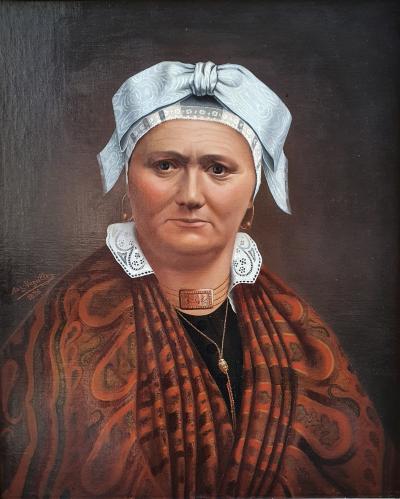
Auguste Vazeille, woman from Le-Puy-en-Velay, 1876
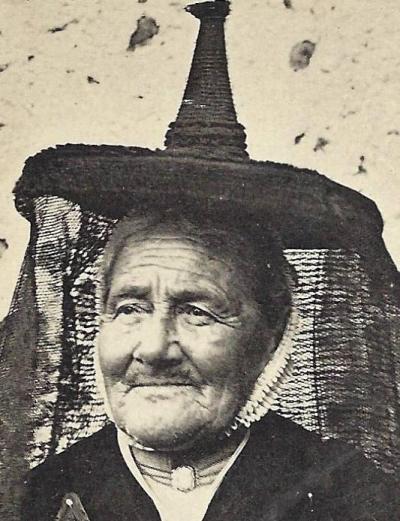
"rang d'or" necklace worn in Bourg-en-Bresse (Ain department)

"rang d'or" necklace in gold
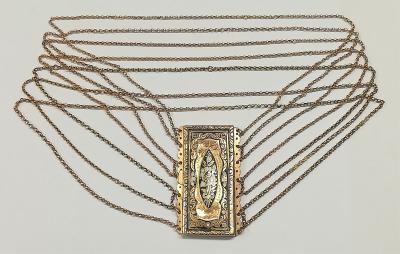
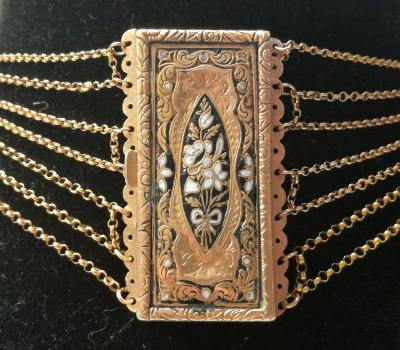
"rang d'or" necklace in gold and enamel

bracelet "rang d'or" in gold
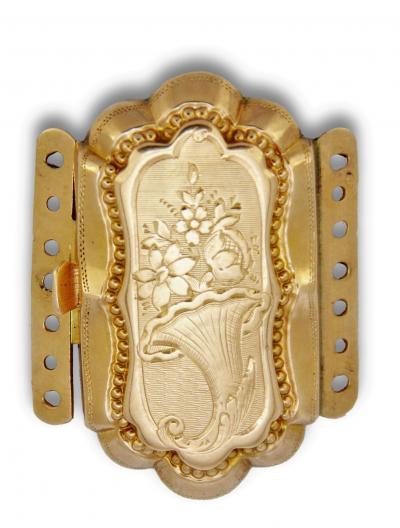
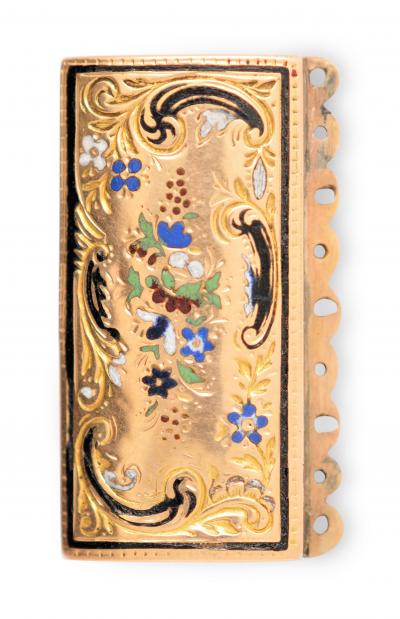
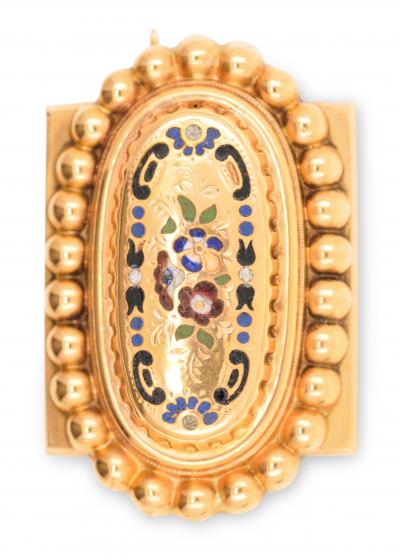
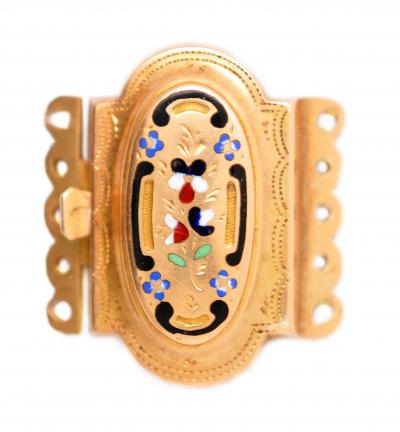
distinctive enamelled "rang d'or" necklace or bracelet catches from Auvergne
Necklace catches from Auvergne
|
|
|
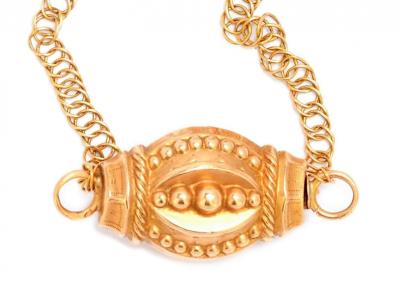
necklace from Auvergne with its distinctive catch and flat link chain
|
|
|
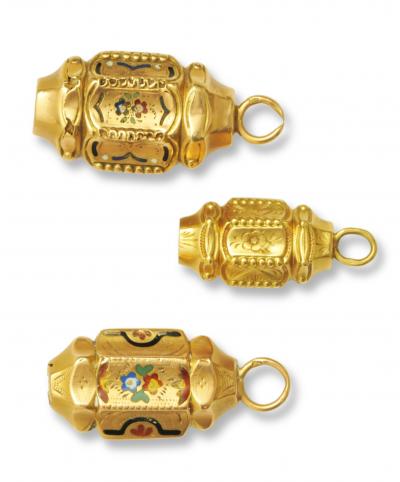
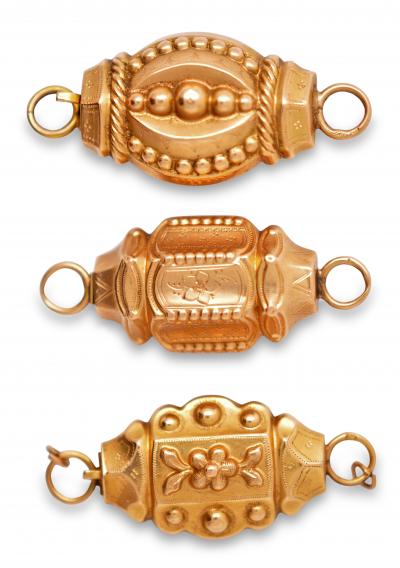
the two main types of necklace catches from Auvergne (enlarged 200%)
The chain clasps or catches from Auvergne are quite different from those of other regions. They are roughly lozenge shaped, flattened in the middle and one of the two types illustrated here is generally enamelled while the other is not.
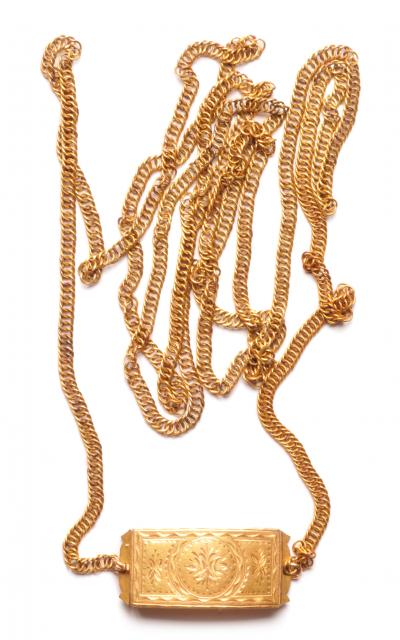
long chain with flat links typical of the Auvergne region - 1798-1809
Serre-malice
Made of brass and brightly polished, the serre-malice is a head-band used to maintain the black cloth used as a coiffe by women until the years 1860-1870 on the plateau of Artense (La tour d'Auvergne) and as far as Aurillac since it was the copper smiths of this city who made it without any welding. In 1834 Jean-Baptiste Bouillet wrote: "We often see at our fairs and our markets women wearing a piece of black cloth, several times folded, and arranged so as to form a point on the back. restrained by an assembly of brass threads, at least one inch in width, acting like a spring and coming to rest on each side of the head, and by a kind of epigrammatic spirit, this ornament is given in the country the name of sara maliça, or “squeeze mischief”. The women of the Artense seldom move away from Auvergne, so their costume, especially their hairstyle, is unknown outside of this province." (2)
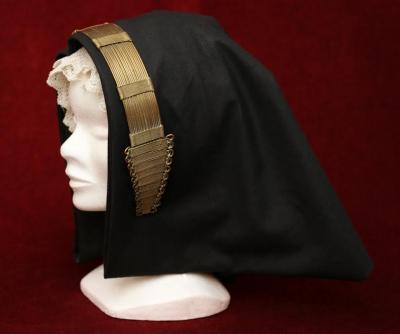
"serre-malice" head-band in brass - photo Musée de la coiffe à Blesle
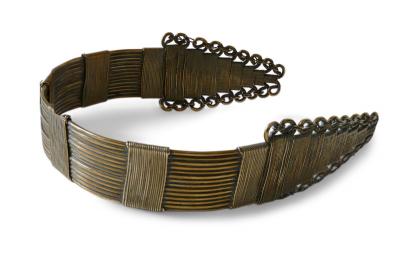
"serre-malice" head-band in brass - photo Musée régional d'Auvergne in Riom
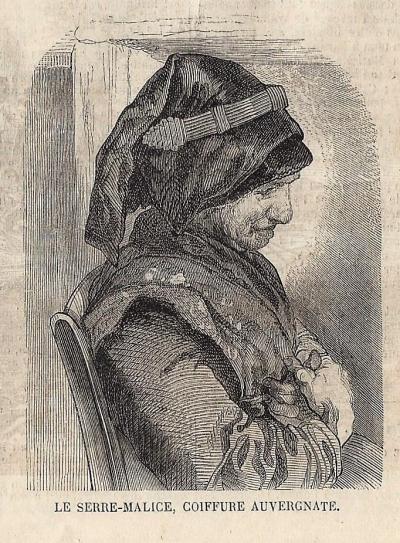
brass head-band known as"serre-malice"
Auvergne clasps or buckles
The silver buckles made in Cantal in the XIX century are of a style unique to this region; a very openwork design with multiple flowers and fastening loops very visible but with a rather basic finish without any work of chiseling or finishing. There is a buckle in the collection of the Ethnographic Museum of the Donjon in Niort somewhat similar in decoration but with a hallmark from Saintes 1819-1838. Inv. 958-1-8. Noel Thiollier in his book "The goldsmiths of Puy-Notre-Dame", (5), was similarly unimpressed with the summry workmanship of these buckles - "It is intentionally that I do not speak of the belt buckles or the clips intended to suspend the scissors that were manufactured in large numbers in Le Puy. Some of them bear the image of the Virgin of Le Puy. The work is too crude for us to consider them the work of silversmiths, they are more like the work of a foundry."
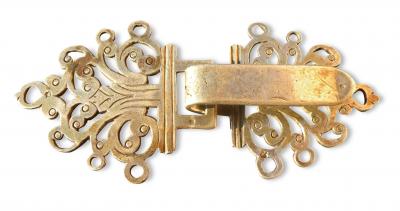
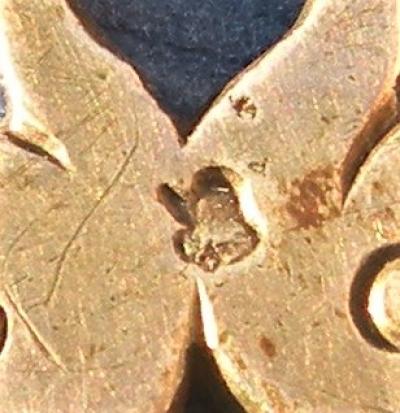
silver clasp from Auvergne, 18th century
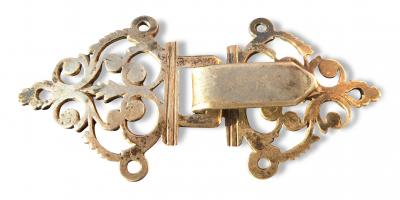
silver clasp from Auvergne, 18th century
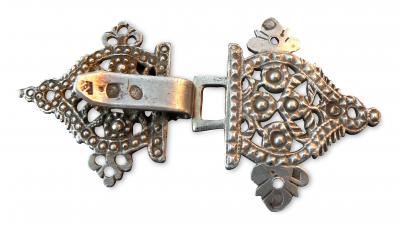
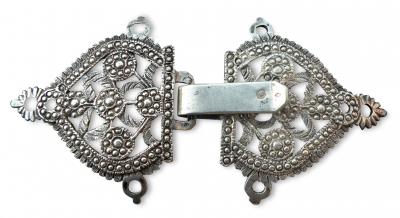
silver clasp from Auvergne, 19th century
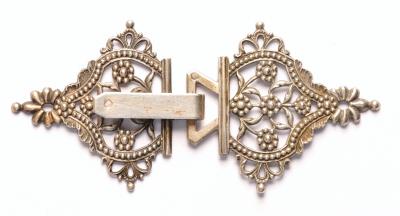
silver clasp from the Cantal region
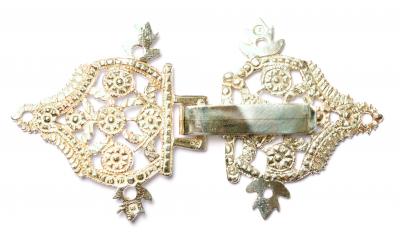
silver clasp from Auvergne, 19th century
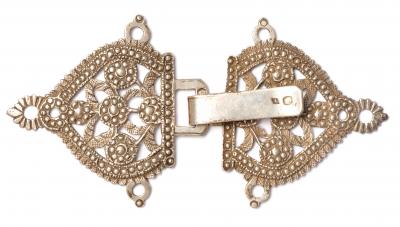
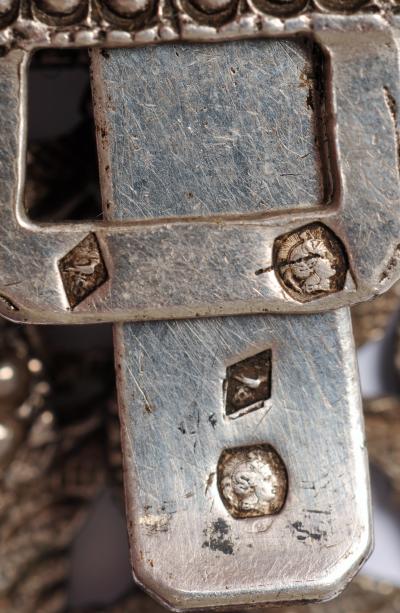
silver clasp from Auvergne, 19th century
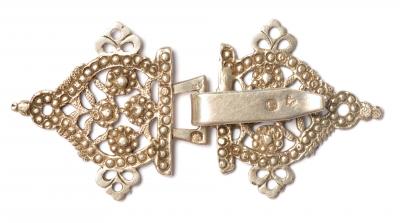
silver clasp from Auvergne, 19th century
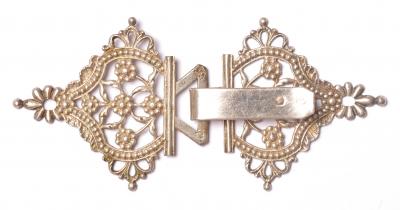
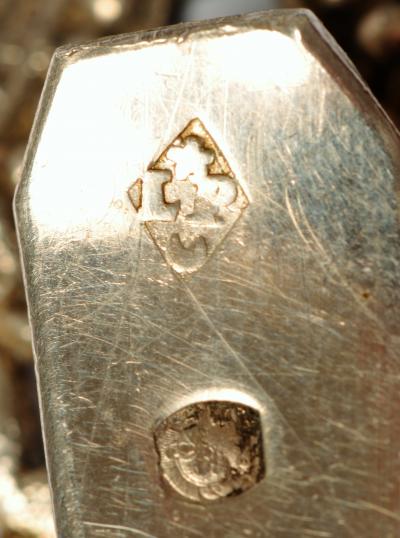
silver clasp from Auvergne, 19th century
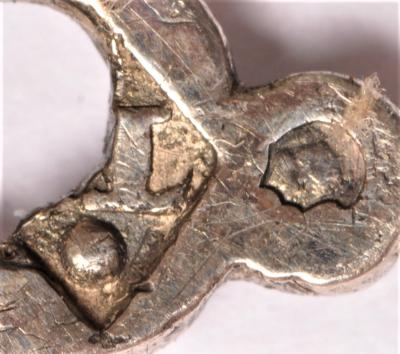
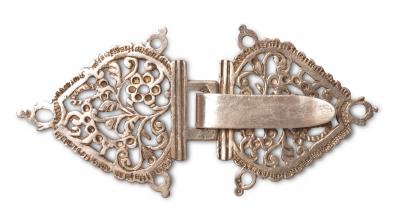
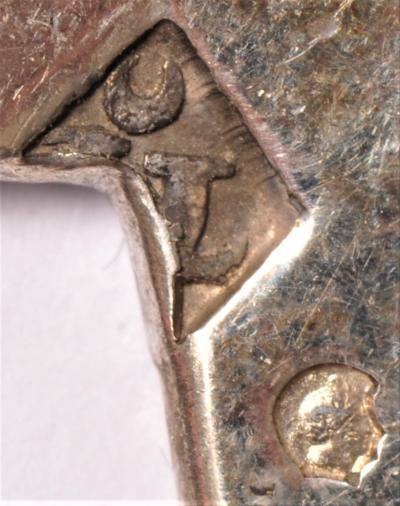
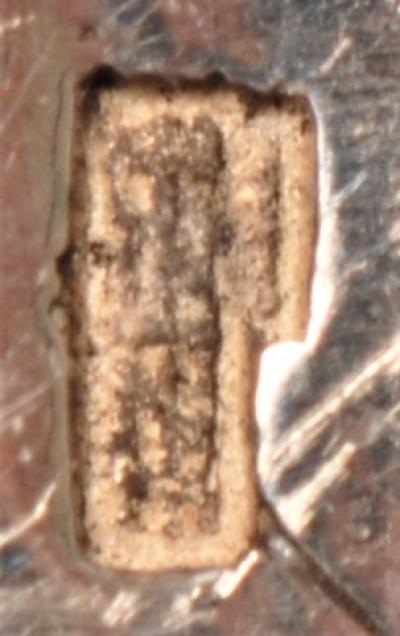
silver clasp from Auvergne, 19th century
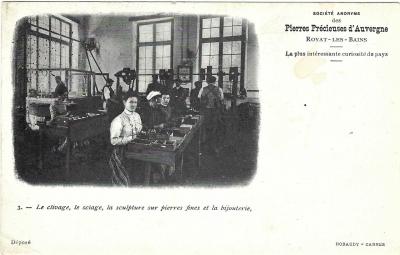
factory workers polishing semi-precious stones in Royat-les-Bains, Auvergne - postcard
click on the photos to see them in high definition
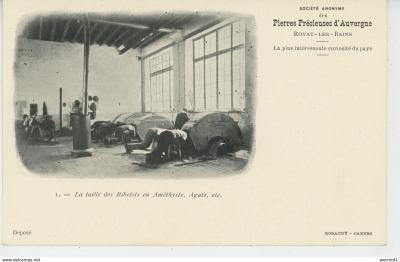
factory workers polishing semi-precious stones in Royat-les-Bains, Auvergne - postcard
note the rather uncomfortable position used by the polishers, knife grinders used the same technique in the past
click on the photos to see them in high definition
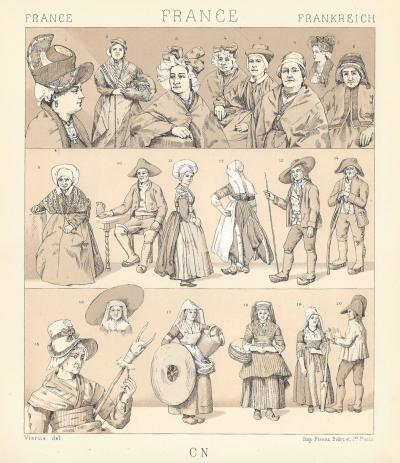
French folk costumes from the Auvergne region as seen by Racinet in "Le Costume Historique, 1888"
click on the photos to see them in high resolution!
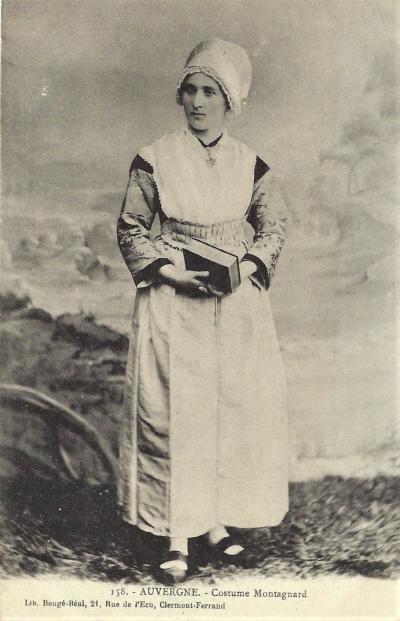
traditional mountain folk dress from Auvergne
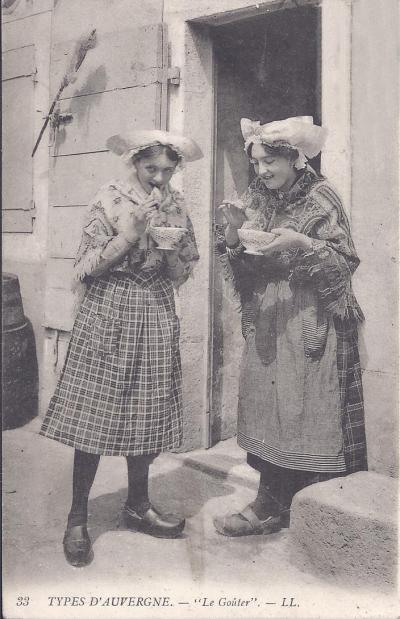
regional costume from Auvergne
bijoux régionaux - bijou régional
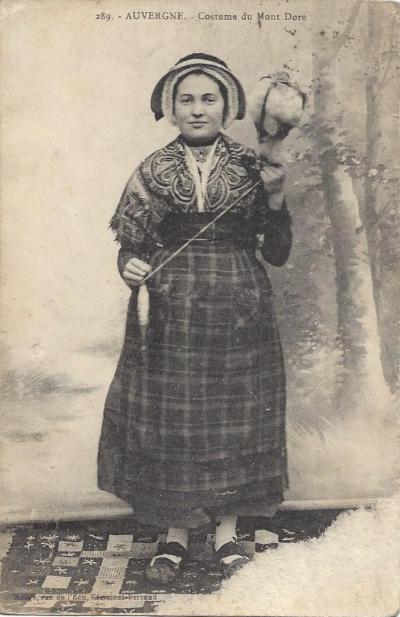
regional costume from Auvergne - Le Mont Doré
bijoux régionaux - bijou régional
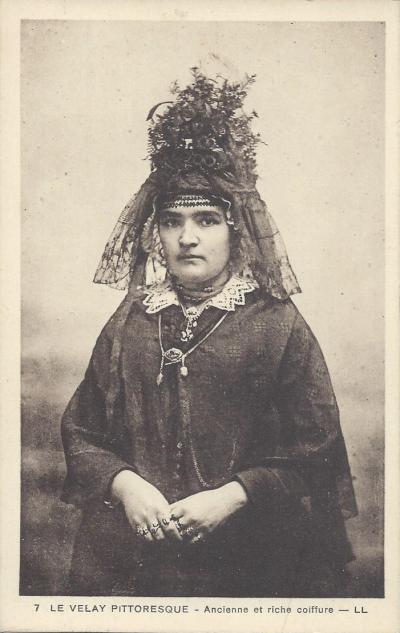
Ancien and rich regional costume from Auvergne
bijoux régionaux - bijou régional
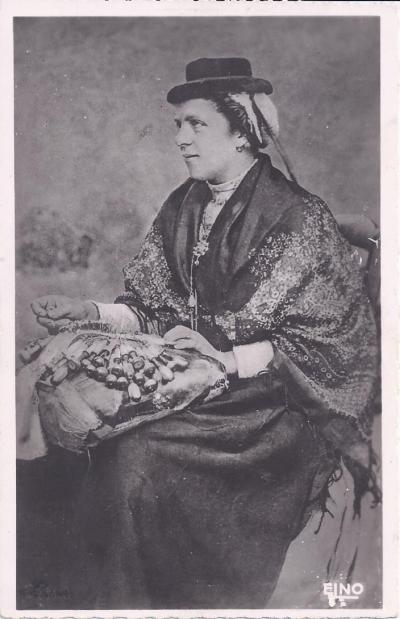
Lace-maker from Auvergne - she's wearing a Rose du Velay pendant
bijoux régionaux - bijou régional

lace-maker from Auvergne
bijoux régionaux - bijou régional
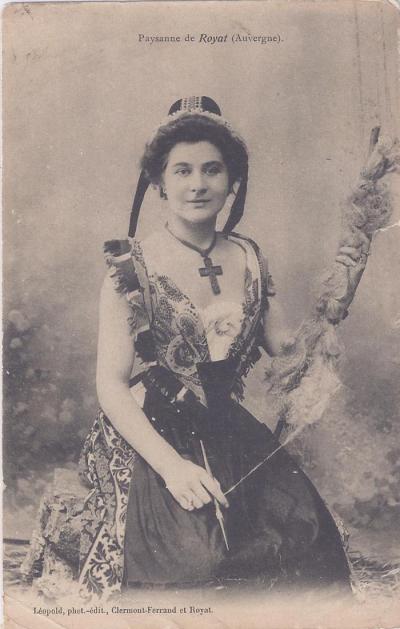
woman from Royat - Auvergne
bijoux régionaux - bijou régional
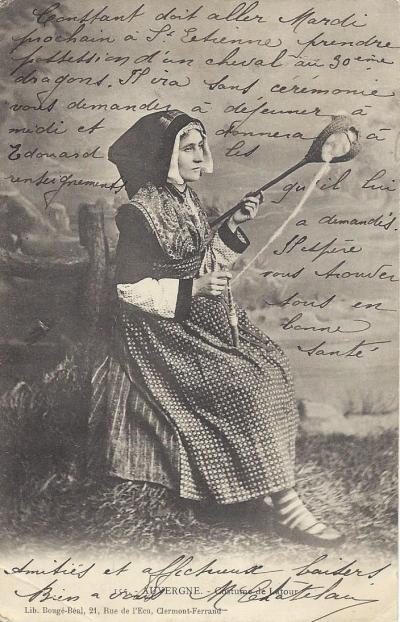
woman from Latour, Auvergne, hand-spinning wool and wearing a Serre Malice
French regional jewellery - Auvergne
New book - Traditional French Jewellery
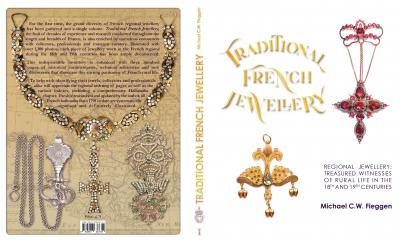
Book - Traditional French Jewellery - order here direct from the author
Dear collectors, auctioneers, dealers and jewellery lovers,
You have visited the site www.bijouxregionaux.com which since 2009 has listed all regional and traditional French jewellery, without advertising and without sales. By popular demand, this website is now finally available as a book, much more complete and with many new photos and texts that are not on the site. I traveled more than 4,500 km in 2020 to visit the various collectors and museums of France and to photograph, weigh, measure and examine their jewellery.
Large format of 23.5 x 30 cm, 304 pages, hardcover and fully illustrated with over 1300 jewels in color, this book is the first complete book on French regional jewellery and corrects the many errors and gaps observed in the other references and presents other regional jewels hitherto unknown to the public. You will find eight full pages on Breton pins and fibulae and many other jewels in museums and private collections that are not on this website. Over four months of research has gone into making the chapter on hallmarks the most reliable ever seen - clear illustrations of hallmarks have been made especially for this volume. And for the first time, collectors will have access to a complete list of all the assay office symbols, small signs withn the hallmarks that identify in which city the jewellery was hallmarked. The opening and closing dates since 1798 of the hallmark offices are also listed for the first time, allowing, with the office symbol, to better date your jewellery.
The print run of this book is very limited, which is why I recommend you order early. You will love this book I have had nothing but compliments and many clients have ordered more to offer as gifts.
To order, you can send a wire transfer or WISE transfer to Michael Fieggen - FR76 4061 8803 9700 0403 3233 171 – BIC – BOUSFRPPXXX - address Mike Fieggen, 280 rue Saint Honoré, Paris, 75001 France
Bank or wire transfer by www.wise.com in Sterling – Account holder - Michael Fieggen
IBAN - GB68TSBS30916200184462 BIC / SWIFT - TSBSGB2AXXX
Sterling cheques and PayPal welcome to address demosthenesparis@gmail.com.
Any questions ? Contact me at bijouregional@gmail.com or by telephone at + 33 1 4015 9000
One copy in French €75 Postage and packing €9 for France, €8 for Europe and overseas
Two or more copies in French €75 each Postage and packing €9 for the lot in France, overseas postage €8 each
One or more copies in English £75 sterling each Postage and packing £8 sterling each








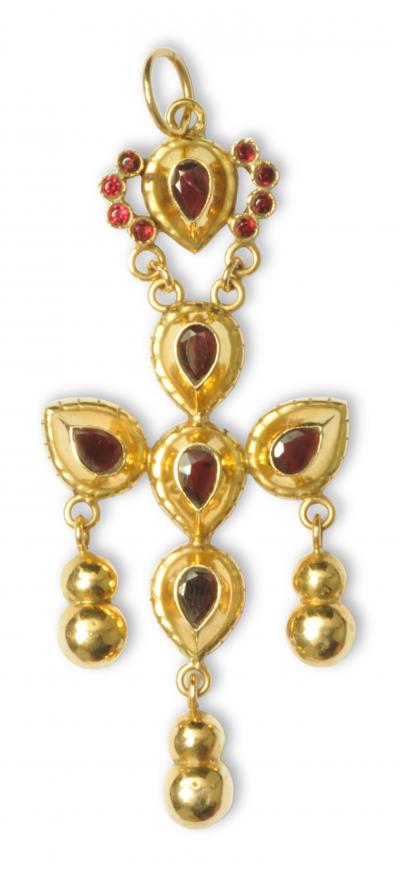
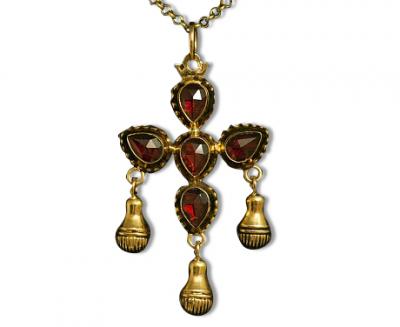
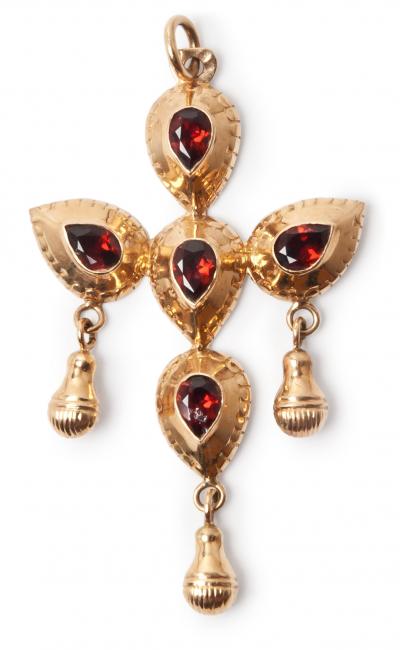








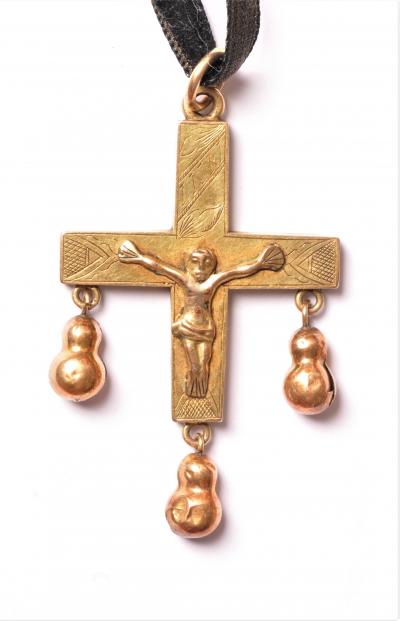
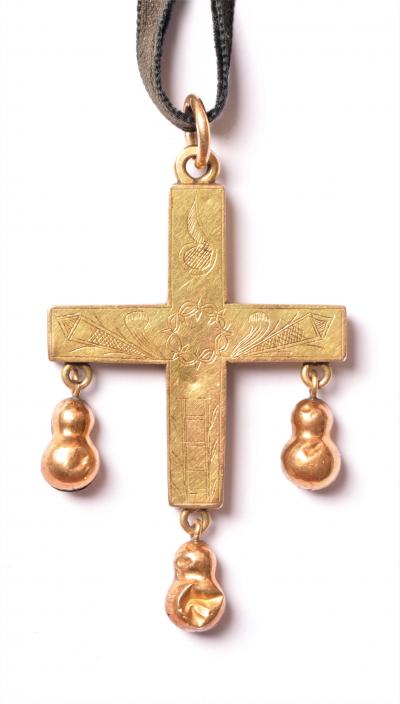




















![Thomas Degeorge - Paysanne assise, 1852 - Musee d'Art Roger-Quilliot [MARQ], Ville de Clermont-Ferrand](/ckfinder/userfiles/images/petits/thomas-degeorge-paysanne-assise.jpg)
